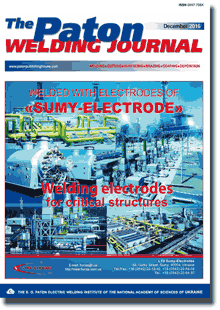| 2016 №12 (03) |
DOI of Article 10.15407/tpwj2016.12.04 |
2016 №12 (05) |

The Paton Welding Journal, 2016, #12, 21-28 pages
Weldability of high-strength microalloyed steel S460M
V.D. Poznyakov, S.L. Zhdanov, A.V. Zavdoveev, A.A. Maksimenko And T.G. Solomijchuk
E.O. Paton Electric Welding Institute, NASU 11 Kazimir Malevich Str., 03680, Kiev, Ukraine. E-mail: office@paton.kiev.ua
Abstract
The structural steels of strength class S350 and higher are widely used in manufacture of metal structures of different purpose. Their application allows significant reducing the total metal consumption of structures as compared to the products of steels of grades St.3 and 09G2S. In the present work the influence of welding thermal cycles on the properties and structure of HAZ metal, resistance of joints to cold crack formation is considered. The selection of welding consumables for steels of strength class S490 was justified and the change of mechanical properties of welded joints was analyzed. It was revealed that with increase in the rate of cooling the HAZ metal of model specimens-simulators, the strength characteristics increase, and the ductile ones decrease. Thus, the values of impact toughness are sharply reduced at the cooling rate of 3 °C/s. It is possible to increase greatly the resistance to cold crack formation in technological samples of steel S460M at the increased content of diffusion hydrogen in the deposited metal by decreasing the value of residual stresses in welded joints to the level not exceeding 0.5sy of steel (≤235 MPa). 13 Ref., 1 Table, 9 Figures.
Keywords: high-strength steel, welding thermal cycle, cooling rate, mechanical properties, cold cracks, diffusion hydrogen, brittle fracture
Received: 21.06.16
Published: 24.01.17
References
- Ufuah, E. (2013) Elevated temperature mechanical properties of butt welded connections made with high-strength steel grades S355 and S460M. In: of Int. Conf. on Design, Fabrication and Economy of Metal Structures (Miskolc, Hungary, April 24–26, 2013), 407–412. https://doi.org/10.1007/978-3-642-36691-8_62
- Nazarov, A., Yakushev, E., Shabalov, I. et al. (2014) Comparison of weldability of high-strength pipe steels microalloyed with niobium, niobium and vanadium. Metallurgist, 7(9/10), 911–917. https://doi.org/10.1007/s11015-014-9821-6
- (1993) Welded building structures. Vol. 1: Basis of structural design. Ed. by L.M. Lobanov. Kiev: Naukova Dumka.
- Tylkin, M.A., Bolshakov, V.I., Odessky, P.D. (1983) Structure and properties of construction steel. Moscow: Metallurgiya.
- Odessky, P.D., Molodtsov, A.F., Morozov, Yu.D. (2011) New efficient low-alloy steels for building metal structures. Montazhnye & Spetsialnye Raboty v Stroitelstve, 5, 20–25.
- Bilyk, A.S., Kurashev, R.V., Gorbatenko, V.V. et al. (2013) Application of thermomechanically strengthened sheet products in welded metal structures. Promyslove Budivnytstvo ta Inzh. Sporudy, 4, 1–4.
- Ragu Nathan, S., Balasubramanian, V., Malarvizhi, S. (2015) Effect of welding processes on mechanical and microstructural characteristics of high strength low alloy naval grade steel joints. Defence Technology, 11, 308–317. https://doi.org/10.1016/j.dt.2015.06.001
- Poznyakov, V.D., Zhdanov, S.L., Maksimenko, A.A. (2012) Structure and properties of welded joints of steel S390 (S355 J2). The Paton Welding J., 8, 6–10.
- Sarzhevsky, V.A., Sazonov, V.Ya. (1981) Unit for simulation of welding thermal cycles on the base of machine MSR-75. Svarka, 5, 69–70.
- Hrivnak, I. (1984) Weldability of steels. Ed. by E.L. Makarov. Moscow: Mashinostroenie.
- Mikhoduj, L.I., Poznyakov, V.D., Yushchenko, A.K. (2000) Resistance of 12KhN2MFDRA steel welded joints to a delayed fracture. The Paton Welding J., 11, 4–10.
- Hall, U., Kukharova, Kh., Zut, V. (1978) Brittle fracture of welded structures. by I.V. Kudryavtsev et al. Moscow: Mashinostroienie.
- Musiyachenko, V.F., Kasatkin, B.S., Zhdanov, S.L. et al. (1981) Examination of conditions of formation and propagation of cold cracks in high-strength steel welded joints by acoustic emission method. Svarka, 7, 5–7.
